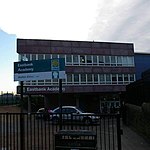Carmyle railway station
1866 establishments in ScotlandBeeching closures in ScotlandFormer Caledonian Railway stationsPages with no open date in Infobox stationRailway stations in Glasgow ... and 7 more
Railway stations in Great Britain closed in 1964Railway stations in Great Britain opened in 1866Railway stations in Great Britain opened in 1993Railway stations served by ScotRailReopened railway stations in Great BritainSPT railway stationsUse British English from July 2022

Carmyle railway station is located in the Carmyle area of Glasgow. It is on the Whifflet Line (a branch of the more extensive Argyle Line), 5.5 miles (8.9 km) east of Glasgow Central railway station. Services are provided by ScotRail.
Excerpt from the Wikipedia article Carmyle railway station (License: CC BY-SA 3.0, Authors, Images).Carmyle railway station
Inzievar Terrace, Glasgow Carmyle
Geographical coordinates (GPS) Address External links Nearby Places Show on map
Geographical coordinates (GPS)
| Latitude | Longitude |
|---|---|
| N 55.8343 ° | E -4.1581 ° |
Address
Carmyle
Inzievar Terrace
G32 8JU Glasgow, Carmyle
Scotland, United Kingdom
Open on Google Maps




